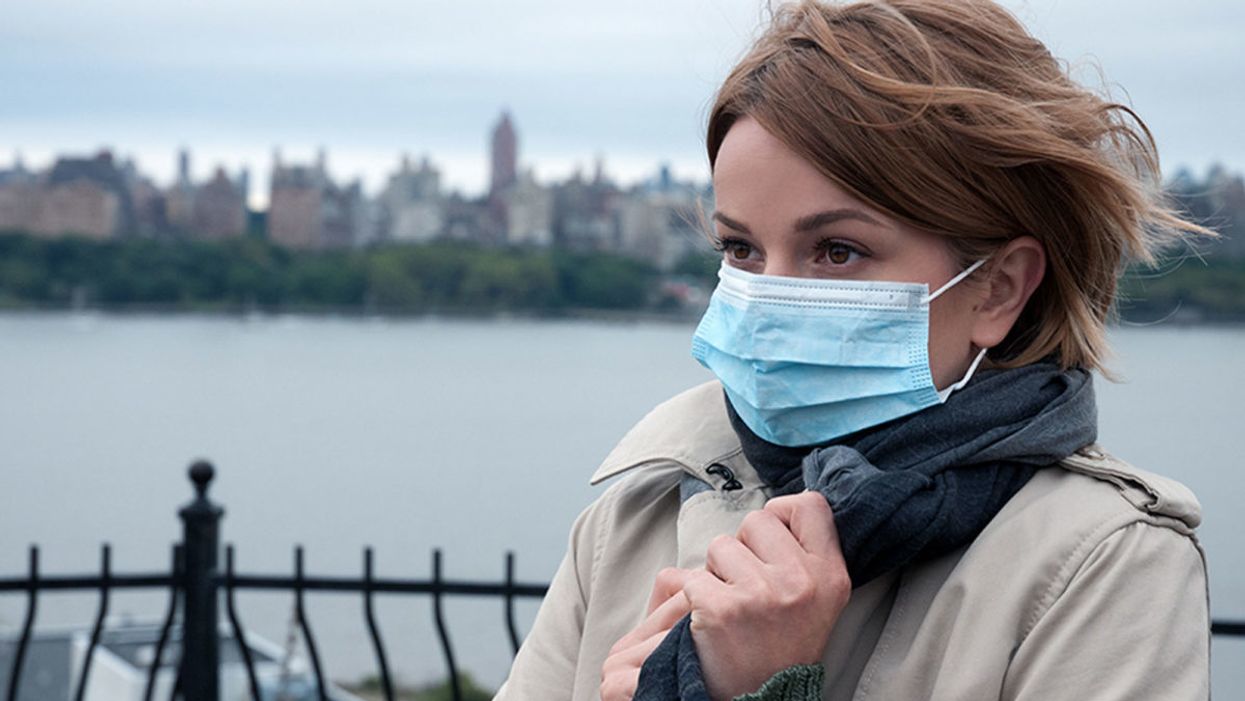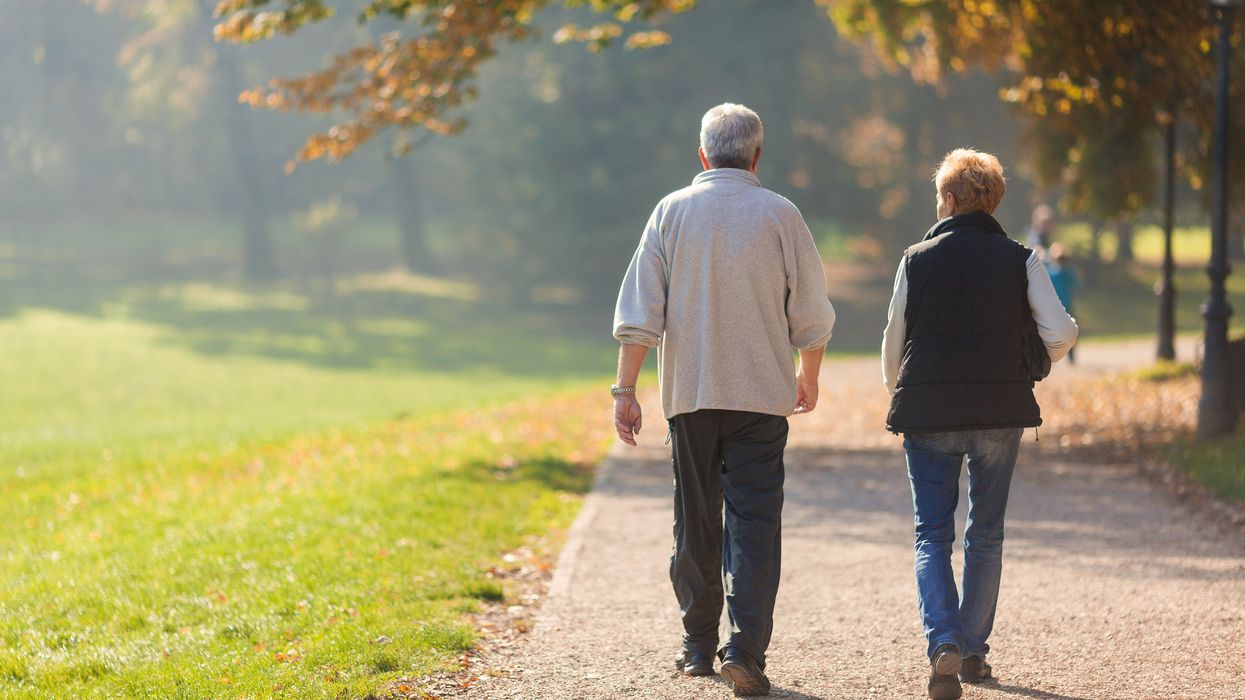Scientists Are Building an “AccuWeather” for Germs to Predict Your Risk of Getting the Flu

A future app may help you avoid getting the flu by informing you of your local risk on a given day.
Applied mathematician Sara del Valle works at the U.S.'s foremost nuclear weapons lab: Los Alamos. Once colloquially called Atomic City, it's a hidden place 45 minutes into the mountains northwest of Santa Fe. Here, engineers developed the first atomic bomb.
Like AccuWeather, an app for disease prediction could help people alter their behavior to live better lives.
Today, Los Alamos still a small science town, though no longer a secret, nor in the business of building new bombs. Instead, it's tasked with, among other things, keeping the stockpile of nuclear weapons safe and stable: not exploding when they're not supposed to (yes, please) and exploding if someone presses that red button (please, no).
Del Valle, though, doesn't work on any of that. Los Alamos is also interested in other kinds of booms—like the explosion of a contagious disease that could take down a city. Predicting (and, ideally, preventing) such epidemics is del Valle's passion. She hopes to develop an app that's like AccuWeather for germs: It would tell you your chance of getting the flu, or dengue or Zika, in your city on a given day. And like AccuWeather, it could help people alter their behavior to live better lives, whether that means staying home on a snowy morning or washing their hands on a sickness-heavy commute.

Sara del Valle of Los Alamos is working to predict and prevent epidemics using data and machine learning.
Since the beginning of del Valle's career, she's been driven by one thing: using data and predictions to help people behave practically around pathogens. As a kid, she'd always been good at math, but when she found out she could use it to capture the tentacular spread of disease, and not just manipulate abstractions, she was hooked.
When she made her way to Los Alamos, she started looking at what people were doing during outbreaks. Using social media like Twitter, Google search data, and Wikipedia, the team started to sift for trends. Were people talking about hygiene, like hand-washing? Or about being sick? Were they Googling information about mosquitoes? Searching Wikipedia for symptoms? And how did those things correlate with the spread of disease?
It was a new, faster way to think about how pathogens propagate in the real world. Usually, there's a 10- to 14-day lag in the U.S. between when doctors tap numbers into spreadsheets and when that information becomes public. By then, the world has moved on, and so has the disease—to other villages, other victims.
"We found there was a correlation between actual flu incidents in a community and the number of searches online and the number of tweets online," says del Valle. That was when she first let herself dream about a real-time forecast, not a 10-days-later backcast. Del Valle's group—computer scientists, mathematicians, statisticians, economists, public health professionals, epidemiologists, satellite analysis experts—has continued to work on the problem ever since their first Twitter parsing, in 2011.
They've had their share of outbreaks to track. Looking back at the 2009 swine flu pandemic, they saw people buying face masks and paying attention to the cleanliness of their hands. "People were talking about whether or not they needed to cancel their vacation," she says, and also whether pork products—which have nothing to do with swine flu—were safe to buy.
At the latest meeting with all the prediction groups, del Valle's flu models took first and second place.
They watched internet conversations during the measles outbreak in California. "There's a lot of online discussion about anti-vax sentiment, and people trying to convince people to vaccinate children and vice versa," she says.
Today, they work on predicting the spread of Zika, Chikungunya, and dengue fever, as well as the plain old flu. And according to the CDC, that latter effort is going well.
Since 2015, the CDC has run the Epidemic Prediction Initiative, a competition in which teams like de Valle's submit weekly predictions of how raging the flu will be in particular locations, along with other ailments occasionally. Michael Johannson is co-founder and leader of the program, which began with the Dengue Forecasting Project. Its goal, he says, was to predict when dengue cases would blow up, when previously an area just had a low-level baseline of sick people. "You'll get this massive epidemic where all of a sudden, instead of 3,000 to 4,000 cases, you have 20,000 cases," he says. "They kind of come out of nowhere."
But the "kind of" is key: The outbreaks surely come out of somewhere and, if scientists applied research and data the right way, they could forecast the upswing and perhaps dodge a bomb before it hit big-time. Questions about how big, when, and where are also key to the flu.
A big part of these projects is the CDC giving the right researchers access to the right information, and the structure to both forecast useful public-health outcomes and to compare how well the models are doing. The extra information has been great for the Los Alamos effort. "We don't have to call departments and beg for data," says del Valle.
When data isn't available, "proxies"—things like symptom searches, tweets about empty offices, satellite images showing a green, wet, mosquito-friendly landscape—are helpful: You don't have to rely on anyone's health department.
At the latest meeting with all the prediction groups, del Valle's flu models took first and second place. But del Valle wants more than weekly numbers on a government website; she wants that weather-app-inspired fortune-teller, incorporating the many diseases you could get today, standing right where you are. "That's our dream," she says.

This plot shows the the correlations between the online data stream, from Wikipedia, and various infectious diseases in different countries. The results of del Valle's predictive models are shown in brown, while the actual number of cases or illness rates are shown in blue.
(Courtesy del Valle)
The goal isn't to turn you into a germophobic agoraphobe. It's to make you more aware when you do go out. "If you know it's going to rain today, you're more likely to bring an umbrella," del Valle says. "When you go on vacation, you always look at the weather and make sure you bring the appropriate clothing. If you do the same thing for diseases, you think, 'There's Zika spreading in Sao Paulo, so maybe I should bring even more mosquito repellent and bring more long sleeves and pants.'"
They're not there yet (don't hold your breath, but do stop touching your mouth). She estimates it's at least a decade away, but advances in machine learning could accelerate that hypothetical timeline. "We're doing baby steps," says del Valle, starting with the flu in the U.S., dengue in Brazil, and other efforts in Colombia, Ecuador, and Canada. "Going from there to forecasting all diseases around the globe is a long way," she says.
But even AccuWeather started small: One man began predicting weather for a utility company, then helping ski resorts optimize their snowmaking. His influence snowballed, and now private forecasting apps, including AccuWeather's, populate phones across the planet. The company's progression hasn't been without controversy—privacy incursions, inaccuracy of long-term forecasts, fights with the government—but it has continued, for better and for worse.
Disease apps, perhaps spun out of a small, unlikely team at a nuclear-weapons lab, could grow and breed in a similar way. And both the controversies and public-health benefits that may someday spin out of them lie in the future, impossible to predict with certainty.
As Our AI Systems Get Better, So Must We
In order to build the future we want, we must also become ever better humans, explains the futurist Jamie Metzl in this opinion essay.
As the power and capability of our AI systems increase by the day, the essential question we now face is what constitutes peak human. If we stay where we are while the AI systems we are unleashing continually get better, they will meet and then exceed our capabilities in an ever-growing number of domains. But while some technology visionaries like Elon Musk call for us to slow down the development of AI systems to buy time, this approach alone will simply not work in our hyper-competitive world, particularly when the potential benefits of AI are so great and our frameworks for global governance are so weak. In order to build the future we want, we must also become ever better humans.
The list of activities we once saw as uniquely human where AIs have now surpassed us is long and growing. First, AI systems could beat our best chess players, then our best Go players, then our best champions of multi-player poker. They can see patterns far better than we can, generate medical and other hypotheses most human specialists miss, predict and map out new cellular structures, and even generate beautiful, and, yes, creative, art.
A recent paper by Microsoft researchers analyzing the significant leap in capabilities in OpenAI’s latest AI bot, ChatGPT-4, asserted that the algorithm can “solve novel and difficult tasks that span mathematics, coding, vision, medicine, law, psychology and more, without needing any special prompting.” Calling this functionality “strikingly close to human-level performance,” the authors conclude it “could reasonably be viewed as an early (yet still incomplete) version of an artificial general intelligence (AGI) system.”
The concept of AGI has been around for decades. In its common use, the term suggests a time when individual machines can do many different things at a human level, not just one thing like playing Go or analyzing radiological images. Debating when AGI might arrive, a favorite pastime of computer scientists for years, now has become outdated.
We already have AI algorithms and chatbots that can do lots of different things. Based on the generalist definition, in other words, AGI is essentially already here.
Unfettered by the evolved capacity and storage constraints of our brains, AI algorithms can access nearly all of the digitized cultural inheritance of humanity since the dawn of recorded history and have increasing access to growing pools of digitized biological data from across the spectrum of life.
Once we recognize that both AI systems and humans have unique superpowers, the essential question becomes what each of us can do better than the other and what humans and AIs can best do in active collaboration. The future of our species will depend upon our ability to safely, dynamically, and continually figure that out.
With these ever-larger datasets, rapidly increasing computing and memory power, and new and better algorithms, our AI systems will keep getting better faster than most of us can today imagine. These capabilities have the potential to help us radically improve our healthcare, agriculture, and manufacturing, make our economies more productive and our development more sustainable, and do many important things better.
Soon, they will learn how to write their own code. Like human children, in other words, AI systems will grow up. But even that doesn’t mean our human goose is cooked.
Just like dolphins and dogs, these alternate forms of intelligence will be uniquely theirs, not a lesser or greater version of ours. There are lots of things AI systems can't do and will never be able to do because our AI algorithms, for better and for worse, will never be human. Our embodied human intelligence is its own thing.
Our human intelligence is uniquely ours based on the capacities we have developed in our 3.8-billion-year journey from single cell organisms to us. Our brains and bodies represent continuous adaptations on earlier models, which is why our skeletal systems look like those of lizards and our brains like most other mammals with some extra cerebral cortex mixed in. Human intelligence isn’t just some type of disembodied function but the inextricable manifestation of our evolved physical reality. It includes our sensory analytical skills and all of our animal instincts, intuitions, drives, and perceptions. Disembodied machine intelligence is something different than what we have evolved and possess.
Because of this, some linguists including Noam Chomsky have recently argued that AI systems will never be intelligent as long as they are just manipulating symbols and mathematical tokens without any inherent understanding. Nothing could be further from the truth. Anyone interacting with even first-generation AI chatbots quickly realizes that while these systems are far from perfect or omniscient and can sometimes be stupendously oblivious, they are surprisingly smart and versatile and will get more so… forever. We have little idea even how our own minds work, so judging AI systems based on their output is relatively close to how we evaluate ourselves.
Anyone not awed by the potential of these AI systems is missing the point. AI’s newfound capacities demand that we work urgently to establish norms, standards, and regulations at all levels from local to global to manage the very real risks. Pausing our development of AI systems now doesn’t make sense, however, even if it were possible, because we have no sufficient ways of uniformly enacting such a pause, no plan for how we would use the time, and no common framework for addressing global collective challenges like this.
But if all we feel is a passive awe for these new capabilities, we will also be missing the point.
Human evolution, biology, and cultural history are not just some kind of accidental legacy, disability, or parlor trick, but our inherent superpower. Our ancestors outcompeted rivals for billions of years to make us so well suited to the world we inhabit and helped build. Our social organization at scale has made it possible for us to forge civilizations of immense complexity, engineer biology and novel intelligence, and extend our reach to the stars. Our messy, embodied, intuitive, social human intelligence is roughly mimicable by AI systems but, by definition, never fully replicable by them.
Once we recognize that both AI systems and humans have unique superpowers, the essential question becomes what each of us can do better than the other and what humans and AIs can best do in active collaboration. We still don't know. The future of our species will depend upon our ability to safely, dynamically, and continually figure that out.
As we do, we'll learn that many of our ideas and actions are made up of parts, some of which will prove essentially human and some of which can be better achieved by AI systems. Those in every walk of work and life who most successfully identify the optimal contributions of humans, AIs, and the two together, and who build systems and workflows empowering humans to do human things, machines to do machine things, and humans and machines to work together in ways maximizing the respective strengths of each, will be the champions of the 21st century across all fields.
The dawn of the age of machine intelligence is upon us. It’s a quantum leap equivalent to the domestication of plants and animals, industrialization, electrification, and computing. Each of these revolutions forced us to rethink what it means to be human, how we live, and how we organize ourselves. The AI revolution will happen more suddenly than these earlier transformations but will follow the same general trajectory. Now is the time to aggressively prepare for what is fast heading our way, including by active public engagement, governance, and regulation.
AI systems will not replace us, but, like these earlier technology-driven revolutions, they will force us to become different humans as we co-evolve with our technology. We will never reach peak human in our ongoing evolutionary journey, but we’ve got to manage this transition wisely to build the type of future we’d like to inhabit.
Alongside our ascending AIs, we humans still have a lot of climbing to do.
Based on recent research, new therapies could promote a mix of viruses in the intestines to help prevent diseases of aging.
Story by Big Think
Our gut microbiome plays a substantial role in our health and well-being. Most research, however, focuses on bacteria, rather than the viruses that hide within them. Now, research from the University of Copenhagen, newly published in Nature Microbiology, found that people who live past age 100 have a greater diversity of bacteria-infecting viruses in their intestines than younger people. Furthermore, they found that the viruses are linked to changes in bacterial metabolism that may support mucosal integrity and resistance to pathogens.
The microbiota and aging
In the early 1970s, scientists discovered that the composition of our gut microbiota changes as we age. Recent studies have found that the changes are remarkably predictable and follow a pattern: The microbiota undergoes rapid, dramatic changes as toddlers transition to solid foods; further changes become less dramatic during childhood as the microbiota strikes a balance between the host and the environment; and as that balance is achieved, the microbiota remains mostly stable during our adult years (ages 18-60). However, that stability is lost as we enter our elderly years, and the microbiome undergoes dramatic reorganization. This discovery led scientists to question what causes this change and what effect it has on health.
Centenarians have a distinct gut community enriched in microorganisms that synthesize potent antimicrobial molecules that can kill multidrug-resistant pathogens.
“We are always eager to find out why some people live extremely long lives. Previous research has shown that the intestinal bacteria of old Japanese citizens produce brand-new molecules that make them resistant to pathogenic — that is, disease-promoting — microorganisms. And if their intestines are better protected against infection, well, then that is probably one of the things that cause them to live longer than others,” said Joachim Johansen, a researcher at the University of Copenhagen.
In 2021, a team of Japanese scientists set out to characterize the effect of this change on older people’s health. They specifically wanted to determine if people who lived to be over 100 years old — that is, centenarians — underwent changes that provided them with unique benefits. They discovered centenarians have a distinct gut community enriched in microorganisms that synthesize potent antimicrobial molecules that can kill multidrug-resistant pathogens, including Clostridioides difficile and Enterococcus faecium. In other words, the late-life shift in microbiota reduces an older person’s susceptibility to common gut pathogens.
Viruses can change alter the genes of bacteria
Although the late-in-life microbiota change could be beneficial to health, it remained unclear what facilitated this shift. To solve this mystery, Johansen and his colleagues turned their attention to an often overlooked member of the microbiome: viruses. “Our intestines contain billions of viruses living inside bacteria, and they could not care less about human cells; instead, they infect the bacterial cells. And seeing as there are hundreds of different types of bacteria in our intestines, there are also lots of bacterial viruses,” said Simon Rasmussen, Johansen’s research advisor.
Centenarians had a more diverse virome, including previously undescribed viral genera.
For decades, scientists have explored the possibility of phage therapy — that is, using viruses that infect bacteria (called bacteriophages or simply phages) to kill pathogens. However, bacteriophages can also enhance the bacteria they infect. For example, they can provide genes that help their bacterial host attack other bacteria or provide new metabolic capabilities. Both of these can change which bacteria colonize the gut and, in turn, protect against certain disease states.
Intestinal viruses give bacteria new abilities
Johansen and his colleagues were interested in what types of viruses centenarians had in their gut and whether those viruses carried genes that altered metabolism. They compared fecal samples of healthy centenarians (100+ year-olds) with samples from younger patients (18-100 year-olds). They found that the centenarians had a more diverse virome, including previously undescribed viral genera.
They also revealed an enrichment of genes supporting key steps in the sulfate metabolic pathway. The authors speculate that this translates to increased levels of microbially derived sulfide, which may lead to health-promoting outcomes, such as supporting mucosal integrity and resistance to potential pathogens.
“We have learned that if a virus pays a bacterium a visit, it may actually strengthen the bacterium. The viruses we found in the healthy Japanese centenarians contained extra genes that could boost the bacteria,” said Johansen.
Simon Rasmussen added, “If you discover bacteria and viruses that have a positive effect on the human intestinal flora, the obvious next step is to find out whether only some or all of us have them. If we are able to get these bacteria and their viruses to move in with the people who do not have them, more people could benefit from them.”
This article originally appeared on Big Think, home of the brightest minds and biggest ideas of all time.
Sign up for Big Think’s newsletter


